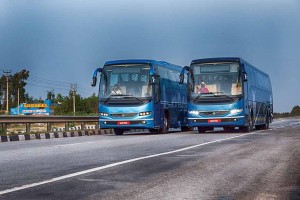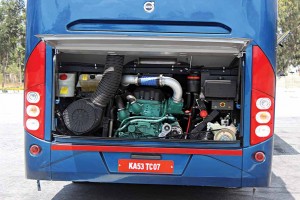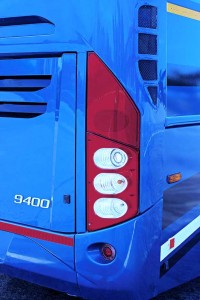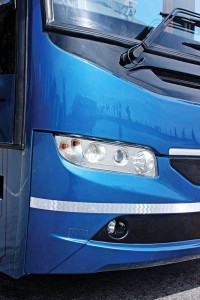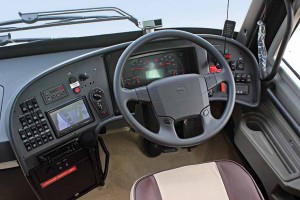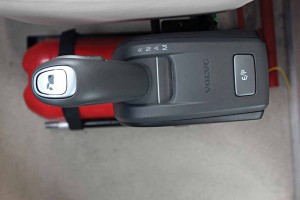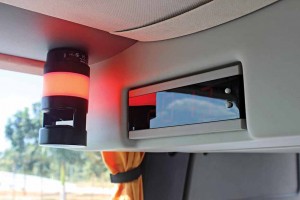Volvo Buses India has upgraded its inter-city bus range; the engines are now BSIV emission compliant.
Story by:
Ashish Bhatia
Volvo Buses commands 65 per cent of the premium luxury inter-city bus market in India. The market is claimed to be a meagre 3 to 4 per cent of the overall bus market in India. Claimed to have kick-started this market in 2001 with its 12 m long B7R two-axle rear-engine bus with body built locally by Azad Coach Builders, the Swedish bus major has come to entrench itself firmly into the Indian market. It has grown with the market over time, retaining its first mover advantage, reaching out to both, the State Transport Undertakings (STUs) and private operators like Neeta, Sharma, VRL, SRS Travels and many more. Taking upon the task of building its own bus bodies by investing in a bus body building facility at Hosakote, Bangalore, in 2008, Volvo Buses India also expanded its product line-up. It added a multi-axle 13.8 m luxury inter-city bus in 2008, a 14.5 inter-city luxury coach in 2012, and a low floor city bus in 2011. Having initiated the trials of its value brand, UD Buses, in 2014, Volvo Buses India has stuck to building premium rear-engine buses. According to VRV Sriprasad, Managing Director, Volvo Buses – South Asia, “The company has always taken the lead in introducing new technologies and concepts, and is working to help ‘create value’.” Despite the advent of competition from global majors like Mercedes-Benz and Scania, Volvo has held on to its own. It has sold over 6000 buses, including 4,500 coaches that are claimed to connect 100-plus locations across India. Over 1,500 Volvo city buses are said to operate in 34 cities in the country. Launching a hybrid city bus in Navi Mumbai last year, Volvo has taken yet another step to further consolidate its place in the burgeoning Indian bus market.
The company has replaced the B7R 12 m platform with B8R. This is the same platform that was the basis for Volvo exporting its first bus to Europe last year with a Euro 6 powertrain. This bus was recently launched in Spain according to Hakan Agnevall, President, Volvo Bus Corporation. The B9R platform has been upgraded to B11R. This platform includes two luxury coaches; one is 13.8 m long and the other is 14.5 m long. Both the buses now sport a 410 hp 11-litre six-cylinder in-line common-rail turbodiesel engine that is BSIV compliant.
The B8R gets a locally manufactured 330 hp, 8-litre common-rail six-cylinder turbodiesel engine that is BSIV compliant. Particular mention should be accorded to the 8-litre engine made at VE Commercial Vehicles engine plant at Pithampur, Indore. It is highly localised and forms the basis for many Volvo group products the world over. With this engine, Volvo Buses India, will be able to address the demand of its customers for localised products. The engine, as the heart of the bus, according to Akash Passey, Senior Vice President – Business Region International, Volvo Bus Corporation, will help to improve the operating performance of the customer, and usher a better experience for those who ride this bus.
Marking the completion of 15 years of Volvo Buses in India, the new upgraded buses are set to keep Volvo ahead of the curve. Building on the familiarity of the brand in India, the B8R and the B11R have also seen some cosmetic changes, both externally and internally. A noticeable change outside is the redesigned grille and head lamp assembly. The head lamp assembly flaunts powerful xenon beams, and is claimed to outperform the halogen lamps the buses came with until now. Flaunting new bumpers at the front and rear, a new feature on these buses is the Rear Vehicle Monitoring (RVM) system. It includes a rear camera that offers a rear-view when reversing in the 2-DIN screen fitted in the driver console. If the bus flaunts aluminium hatches on the storage lid and the engine hatch at the rear, the high levels of fit and finish standards. are clearly evident.
There is a perceptible change evident inside too. Not limited to fit and finish, it is also about the 2×2 seating arrangement as well as the 2×1 seating arrangement. The 14.5 m 2×1 B11R bus came fitted with Prakash Fainsa seats, which marks a departure from Harita Seating, which until now was regarded as the standard for seating systems in premium luxury buses. The 2×1 seating arrangement made for a spacious feel. Also fitted on this bus was a pantry and a chemical toilet. These are meant to serve the needs of travellers during long distance rides. Featuring five fire extinguishers, the bus, complying with the AIS 052 bus code, is fitted with an emergency door at the rear right. A digital nose, fitted in the ceiling, detects any drop in oxygen level, and alerts the driver. The driver drowsiness assist feature is optional, and can detect a change in driver attention. Also fitted are three high-definition CCTV cameras and passenger alert systems.
The driver cockpit includes a sprawling dash with the instrument console at the centre. Two big dials are that of a speedo and a tacho. Two smaller dials on either side of a LCD screen are that of turbo pressure, temperature, fuel level, and air pressure respectively. To the right of the instrument console is the parking brake lever, and a set of switches including the one that helps to adjust the rear-view mirrors. To the left of the instrument console is a bank of switches that include passenger cabin lighting, and various other ancillary lighting functions including the one for the chemical toilet. There’s an AC console, head light and fog lamp switch and a (head lamp) leveller. There’s a 7-inch LCD screen too. The media head unit is built into what could be termed as the center console. The driver seat is adjustable, and makes for a comfortable driving position. The turn of key has the needles rising. They settle down as the engine wakes up to life. Since it is at the rear, not much noise travels to the front. It is the instruments that are the sole indication of the state the engine is in. The LCD screen at the center indicates the gear the I-shift transmission is in; if it is in neutral. The screen incorporates a fully-integrated master multiplex architecture for on-board diagnosis. The optional Alco-lock breath analyser mounted on the pillar to the right signals the bus to not start if the driver fails the breath test! The driver drowsiness console on the dash is also optional, and has a camera fitted in it. It records the driver’s eye movements, and sounds a chime if it detects driver’s eyelids are batting slowly.
Another interesting feature is the ‘I-coach’. It guides the driver through voice commands on the use of critical parameters like energy and torque. It coaches him to extract power optimally. The geo-fencing function as part of the I-coach records the mistakes committed by the driver to help him improve his skills. With telematics on offer, this bus, as I ease it out of parking, is one of the most modern premium segment buses available in India. The 12-speed Automated Manual Transmission (AMT) is slotted in ‘D’. It mimics an auto transmission, and there’s no clutch for me to worry about. Its the expanse of the bus that I need to worry about. This one’s really long at 14.5 m. The rear-view mirrors are of much help. The low seating position ensures that I look up to the mirrors while being seated comfortably with an almost uninterrupted view of what is there in the front. Belting out 410 bhp, the new upgraded 11-litre BSIV compliant common-rail turbodiesel six-cylinder engine of this bus makes it perhaps the most powerful in its class. This is evident as I step on the accelerator once out on an open stretch of tarmac. The bus surges ahead, the whopping 1980 Nm peak torque unleashed between 950-1400rpm ensuring swift progress. The B11R with its upgraded engine feels quick and powerful no doubt, it also feels very refined. Quite unlike the front-engine buses that are found in abundance in India.
Despite its 19,500 kg weight, the B11R responds with good alacrity as I pilot it over Volvo’s track at Hosakote, Bangalore. With the lever in ‘D’, the gears change as the gradient of the track changes, and with it, the speed and load. This is indicated by the ratio the transmission has currently selected in the LCD screen. As I see it, the bus is currently in fourth gear. As speeds rise, the transmission steadily shifts up. Speeds rise; the speedo needle has come to hover around the 50 kmph as the bus travels over a straight stretch. Turns is where the challenge to pilot this bus lies. It needs to be gently guided into and out of turns considering its length and the rear overhang. The longest bus one can lay their hands on, the B11R can seat 37 people with 2×1 seating arrangement. The 2×2 seating arrangement enables the bus to accommodate 57 passengers. The Electronically Controlled Suspension (ECS) – pnuematic in nature – makes for a comfortable ride. The steering feels precise though not as tight as that of a passenger car. This is a bus, and the steering wheel is quite large in diameter. Larger than my Fabia’s steering wheel. Confident, I decide to pilot the bus through a narrow curvy stretch of the track. At one point it calls for a stop and go. The ‘hill-start’ helps. The bus moves ahead. Interestingly, it does not feel like it, but the rear steerable tag axle is helping the bus to negotiate tight corners by modifying (reducing) the turning radius. The tag axle wheels turn in a certain proportion to the front wheels. They steer in the opposite direction!
The Electronic Braking System (EBS) presents the Volvo bus with an impressive braking ability. The brakes are pneumatically operated, and are ABS equipped. A mere touch of the pedal is enough to retard the bus. Brakes are discs all round, and their temperature is monitored to ensure their optimal efficiency and ability. The Electronic Stability Program (ESP) reduces the risk of a roll over. Also included, an advanced anti-skid system, applies the brakes if it detects any abnormal movement. Each wheel brakes individually to stabilise the coach while reducing power to the drive wheels. For control while driving down a slope, the bus is equipped with a speed retarder. It works in tandem with the brakes to ensure safe deceleration. Reflective of how far, and how fast technology has progressed to make the lives of bus commuters comfortable, the Volvo 14.5 m bus sets the standard. It is estimated to cost in the region of Rs. 1.15 crore. For an operator who would spend such an amount on a bus, the proposition has got to be solid. This is exactly what the Volvo B11R is built to support. It is a world-class machine. It is solidly built, and would like to spend most of its life on the road, taking long strides, time and again.
VRV Sriprasad, Managing Director, Volvo Buses – South Asia.
Q. As the first to launch a hybrid bus in the country, are you content with the market acceptance?
A. Unlike plug-in hybrid buses, diesel hybrids do not bank upon the supporting infrastructure. Nothing specific is therefore required from the government. As a government policy, there is the Faster Adoption and Manufacturing of Hybrid and Electric (FAME) vehicle scheme. It is a very big facilitator and enabler for hybrid and electric vehicles. Volvo was the first to qualify and deliver buses under the FAME scheme. At Volvo Buses India we have been in constant dialogue with the government to let the scheme to continue. If it does, it will provide good motivation for corporations to utilise the subsidy and bridge the capital cost gap in a given framework.
Q. Is the subsidy under the FAME scheme enough?
A. For the start, we cannot complain. Consider the example of our hybrid bus. It qualifies as a strong hybrid. The customer is thus entitled to a subsidy of Rs.61 lakh for a bus that costs Rs.2.3 crore. That is a fairly substantial sum. With performance an important aspect of hybrid vehicles, the concept is gaining acceptance. Once it attains a certain threshold, we can push the Ministry of Heavy Industries to look at higher subsidy. It would have to come from all the stakeholders involved.
Q. How has been the feedback for the hybrid buses supplied to Navi Mumbai Muncipal Transport (NMMT)?
A. We are engaged with NMMT. It has acknowledged fuel savings upwards of 33 per cent when compared to conventional diesel buses that they operate. We feel that NMMT could speak to their passengers to gauge their experience of traveling in a hybrid bus in comparison to a conventional diesel bus. If the STU is looking to position itself as forward looking, we believe they will go for more hybrid buses.
Q. What part is Volvo Buses playing in Group synergies?
A. There is definitive synergy at play within the Group at the engineering level. I would not want to comment on synergy at the business level in India at this stage.
Q. Volvo Group partner Nova bus has introduced plug-in hybrid and full electric buses. Is a similar proposition viable in India?
A. In India, it will be just the Volvo brand for now. We also have Sunway as another joint venture partner in China which is a provider of hybrids. However it is too nascent to look at such partnerships for India’s hybrid bus segment.
Q. What do you think is the biggest differentiator for Volvo Buses?
A. We have been testing electromobility solutions for long. A hybrid or electric vehicle we launch is a culmination of years of testing and validation. This is the biggest differentiator. When money is spent to buy a bus, the buyer is assured of getting a tested product; he is assured of its performance. At Volvo, we spend a considerable amount of time to bring out a product. Time is spent on intense testing and validation of the product. No decision is taken in an adhoc manner. Nobody can claim to have perfected the hybrid technology. Battery technology continues to evolve. In the case of hybrid bus batteries, the challenge faced is to make them suitable for adverse climates, hot and humid regions especially. It is a big challenge in India. We have restricted hybrid buses to cities where we are sure the temperature and humidity levels do not exceed a particular level. We are pragmatic; we are not holding back. In India, it may seem like the customers and competition are rushing ahead. Such an approach does not align with our philosophy.
Q. Are you looking at engaging global partners like ABB Tosa to build electric bus charging infrastructure in India?
A. Globally we work together and the electric buses for Sweden are being planned in partnership with them. In India, we are yet to decide on introducing electric buses. These buses would be launched in Sweden by the year 2018. Only post this will we be able to look at a time-line for India.
Q. Since you are pitching hybrid buses to various STUs, are you looking at any volumes?
A. I would not be able to put a number to it. The annual capacity of the Hosakote plant is 1500 units. It is not fully utilised. If I get a 300 vehicle (hybrid bus) order, I shall be able to deliver it in a period of six months given the surplus capacity I have at my disposal.
Q. What is the local content of Volvo Buses in India?
A. In the case of the body, we have localised 100 per cent. On the chassis front, much of the content is coming from Sweden. In the 12 m bus, the engine, we have started sourcing from Pithampur. We are on a program to increase localisation going forward.
Q. Lithium-ion battery prices are said to spiral downwards. Will it make hybrid buses attractive?
A. There could be a point of inflection or deflection where it could lead to the rates suddenly falling. It is then that we would look at volume benefits.
Q. The National Electric Mobility Mission (NEMMP) plan envisages seven million hybrid buses by 2020. Is it achievable?
A. We see some traction on cars and plug-ins. While the count is achievable cumulatively, it would be premature to estimate such a count exclusive to buses.
Q. How will electromobility align with other mobility medias like intra-city and inter-city modes of transport in the future?
A. In the core areas of a city, and in ‘no pollution’ areas, pure electric is the way forward. Away from the core areas, plug-in hybrids could fit the bill. In the case of diesel hybrids, which do not require a dedicated infrastructure, suburbs could be the best region to ply. In the case of inter-city travel, we do not see the possibility of replacing diesel powered buses anytime soon.



